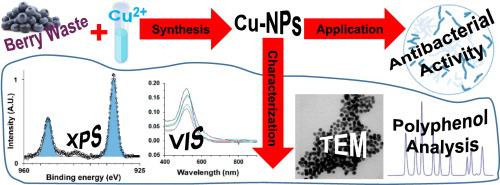Biomaterials Advances ( IF 7.9 ) Pub Date : 2020-08-29 , DOI: 10.1016/j.msec.2020.111453 Emilia Benassai , Massimo Del Bubba , Claudia Ancillotti , Ilaria Colzi , Cristina Gonnelli , Nicola Calisi , Maria Cristina Salvatici , Enrico Casalone , Sandra Ristori

|
The aim of this work was the green synthesis of copper nanoparticles (Cu-NPs) using aqueous extracts of (i) bilberry (Vaccinium myrtillus L.) waste residues from the production of fruit juices and (ii) non-edible “false bilberry” fruits (Vaccinium uliginosum L. subsp. gaultherioides). Different cupric salts (CuCl2, Cu(CH3COO)2 and Cu(NO3)2) were used for the synthesis. The formation of stable nanoparticles (CuNPs) was assessed by transmission electron microscopy and the oxidation state of copper in these aggregates was followed by X-ray photoelectron spectroscopy. The polyphenol composition of the extracts was characterized, before and after the synthesis, using spectrophotometric methods (i.e. total soluble polyphenols and total monomeric anthocyanins) and high-performance liquid chromatography coupled with tandem mass spectrometry (i.e. individual anthocyanins). Polyphenol concentration in the extracts was found to decrease after the synthesis, indicating their active participation to the processes, which led to the formation of Cu-NPs. The antimicrobial activity of Cu-NPs, berry extracts, and cupric ion solutions were analysed by broth microdilution and time-kill assays, on prokaryotic and eukaryotic models. The antimicrobial activity of Cu-NPs, especially those derived from bilberry waste residues, appeared to be higher for both Gram-negative and Gram-positive bacteria, and for fungi, compared to the ones of its single components (cupric salts and berry extracts). Therefore, Cu-NPs from the green synthesis here proposed can be considered as a cost-effective sanitization tool with a wide spectrum of action.
中文翻译:

通过从牛痘菌种中提取不可食用和废弃的植物材料,以绿色且经济高效的方式合成铜纳米颗粒:表征和抗菌活性
这项工作的目的是使用(i)果汁生产中的越桔(Vaccinium myrtillus L.)废渣和(ii)不可食用的“假越桔”的水性提取物绿色合成铜纳米颗粒(Cu-NPs)。水果(笃斯越桔属亚种。gaultherioides)。不同的铜盐(CuCl 2,Cu(CH 3 COO)2和Cu(NO 3)2)用于合成。通过透射电子显微镜评估稳定的纳米颗粒(CuNPs)的形成,并通过X射线光电子能谱跟踪这些聚集体中铜的氧化态。在合成之前和之后,使用分光光度法(即总可溶性多酚和总单体花色苷)和高效液相色谱-串联质谱(即单独的花色苷)对提取物中的多酚成分进行表征。合成后发现提取物中的多酚浓度降低,表明它们积极参与了该过程,从而导致了Cu-NP的形成。通过肉汤微量稀释和杀灭时间测定法分析了铜纳米颗粒,浆果提取物和铜离子溶液的抗菌活性,在原核和真核模型上。与单个成分(铜盐和浆果提取物)相比,Cu-NPs,特别是那些来自越橘废渣的抗菌剂,对革兰氏阴性菌和革兰氏阳性菌以及真菌均具有更高的抗菌活性。 。因此,此处提出的绿色合成中的铜纳米颗粒可被视为具有广泛作用的经济有效的消毒工具。



























 京公网安备 11010802027423号
京公网安备 11010802027423号